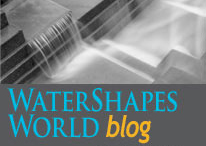ARTICLES
Advance Search
Aquatic Health
Aquatic Health, Fitness & Safety
Around the Internet
Aquatic Culture
Aquatic Technology
Artful Endeavors
Celebrity Corner
Life Aquatic
Must-See Watershapes
People with Cameras
Watershapes in the Headlines
Art/Architectural History
Book & Media Reviews
Commentaries, Interviews & Profiles
Concrete Science
Environment
Fountains
Geotechnical
Join the Dialogue
Landscape, Plants, Hardscape & Decks
Lighter Side
Ripples
Test Your Knowledge
The Aquatic Quiz
Other Waterfeatures (from birdbaths to lakes)
Outdoor Living, Fire Features, Amenities & Lighting
Plants
Ponds, Streams & Waterfalls
Pools & Spas
Professional Watershaping
Structures (Editor's Notes)
Travelogues & History
Water Chemistry
WaterShapes TV
WaterShapes World Blog
Web Links
Around the Internet
Aquatic Culture
Aquatic Technology
Artful Endeavors
Celebrity Corner
Life Aquatic
Must-See Watershapes
People with Cameras
Watershapes in the Headlines
As I read Robert Nonemaker's article on the recommissioning of the Main Fountain Garden at Longwood Gardens while uploading it to the WaterShapes web site, one comment he made stuck in my mind: Seeing that fountain as a ten-year-old, he wrote, was one of his inspirations for becoming a watershaper. I didn't have that sort of uplifting aquatic experience as
If friends had told me that, eight years after leaving the Las Vegas desert, I'd be incorporating synthetic turf in a high percentage of my outdoor spaces in Texas, I would've said "No way!" What a concept! I now live and work where there's no water shortage, so why on earth would my clients or I have any interest in finding substitutes for big expanses of lawn? Well, what I'm seeing now is that the low-maintenance, long-lasting faux-grass solution is
Whenever we approach a pond design/installation project, we are mindful of the fact that a big part of our mission is to make the result as trouble-free as possible for our clients. It is never our intention to mess with their good moods, nor is it our practice, if things need adjusting later on, to avoid digging in as deep as may be necessary and finding a once-and-for-all solution to whatever the problem might be. The project on display in this set of four brief videos is living proof that
To say that I've avidly followed the just-completed process of restoring and renovating the Main Fountain Garden at Longwood Gardens is putting it mildly: This water display has been part of my life since I was ten years old, and I'm proud to say that it's responsible both for my profound interest in water in motion and in some ways for my being a professional watershaper today. So it makes sense that I was there at Longwood Gardens (Kennett Square, Pa.) on May 27, 2017, when the fountain
Years ago, my wife and I made a pact that we'd do our best to visit Yosemite National Park at least every other year. With a couple exceptions - including a four-year gap since our last visit in 2013 - we've met that commitment. We took our three girls on the first several trips; we've gone by ourselves once or twice since our nest emptied, but we generally try to persuade
Swimming continues to grow as a preferred method of exercise and physical therapy for people of all ages, with commercial aquatic facilities seeing healthy increases in patronage year after year. And whether it's water aerobics, resistance training, water walking or aquatic yoga, there's now much more to this popularity than traditional swim lessons for newcomers and laps or competitions for those with developed swimming skills. With this popularity comes
‘With spring upon us,’ began Stephanie Rose’s column in May 2007, ‘calendars of local events are filling up with garden tours of all shapes and sizes. From large estate tours and special events at botanical gardens to tours of wonderful neighborhoods staged by local garden clubs, there’s much to be seen while wandering through
One of the least heralded factors in pond health is also among the most significant: It's all about oxygen, writes Ed Beaulieu, who reviews the basics while offering some suggestions on how to keep it's level up where it needs to be to make both fish and plants happy.





















Visual Acceptance